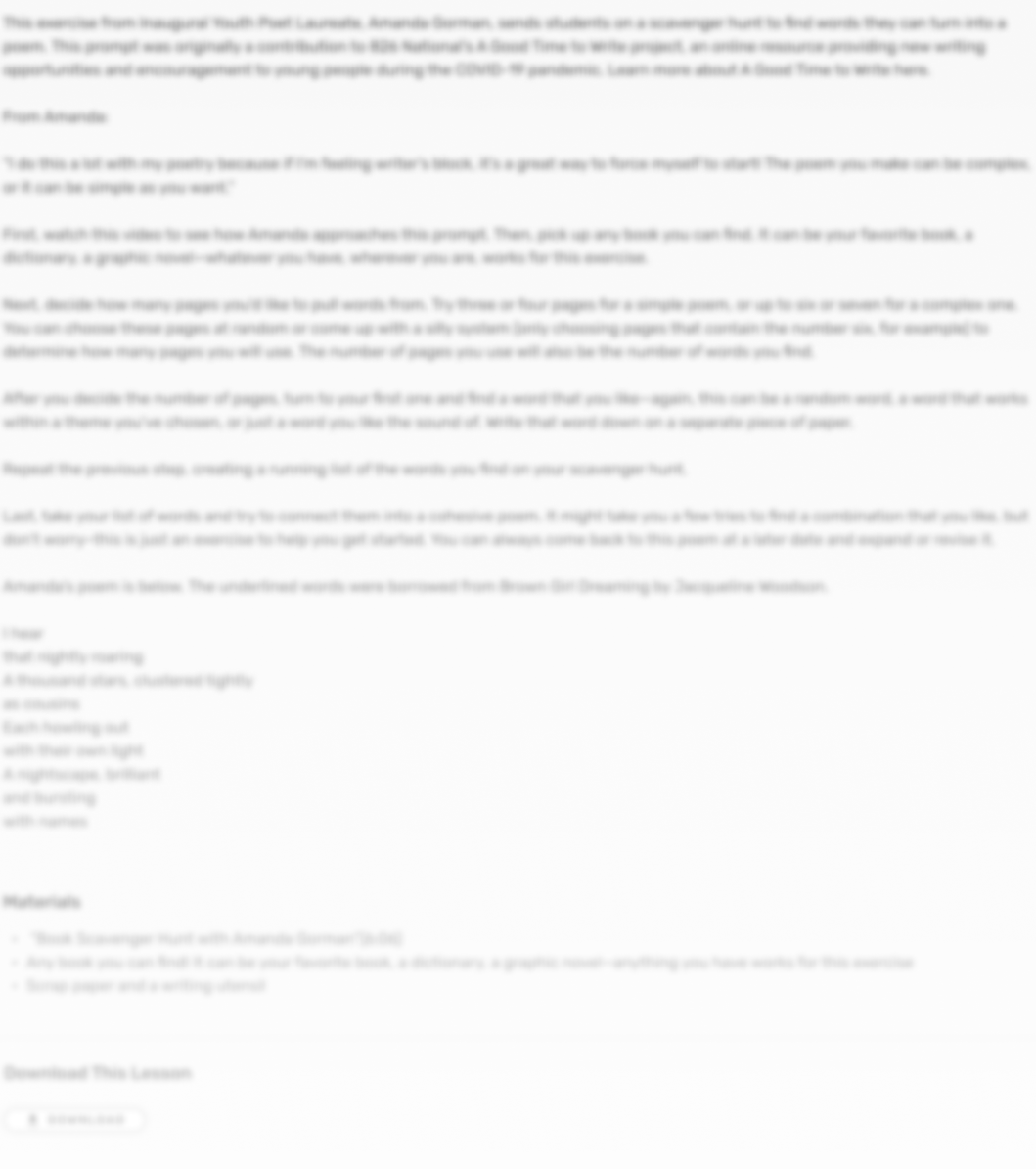 Grades 3–5
Grades 3–5 Poetry
Poetry Videos
VideosIn addition to working as the Program Director at 826 MSP, Cristeta is an audio producer, journalist, and writer. As a writer of color, she values the amplification of fellow voices to bring greater equity to the storytelling landscape. When she gets to share stories that impact her community–like how neighborhood parks matter in the fight for social justice, or the impact of racial profiling of African immigrants in police reports–that work makes her feel part of something bigger than herself.
You will learn how the physical shape of a poem can impact its meaning, tone, and beauty.



In poetry, form refers to a poem’s structure or shape. Generally, a poem is recognized by shorter blocks of text, called stanzas, which are made up of individual lines. In this lesson, you will analyze how different visual elements affect a poem’s meaning, and then write a visual poem of your own.
STEP 1
First, watch the video and follow along with the Mentor Text on page 1 of the Meaning From Shape—Handout After you’ve watched the video, answer the question at the bottom of page 1.
STEP 2
Next, you will analyze how the poem’s shape affects the meaning, tone, and beauty of the poem. Tone refers to the overall mood or vibe of the poem. Answer the reflection questions found on page 2 to complete this step.
STEP 3
Now it’s your turn! In this step, you will write a simple poem that...

by 826 National, featuring Iman Abdullah, Grade 2, 826NYC
Have you ever thought about what you have in common with an animal? In this lesson, students will write a comparison poem that explores these similarities and differences.
by Molly Sprayregen, 826CHI
Writer and 826michigan staffer Denise Ervin writes alongside students to show what feelings sound like.
by 826 National
In this lesson, you will create a simple scrapbook that showcases the facts, definitions, and details you’ve learned about a few of the items you found in a scavenger hunt.
by 826 National
Novelist and short story writer, Caitlin Horrocks, reads "My Full Yard" by Marisol of 826michigan and reflects on the imagery used in the poem.
by 826 National
Misinformation Specialist with Google Nidhi Hebbar shares how you can use writing to inspire change and bring people into conversations about the issues you care about.
by 826 National, featuring Naomi Ku, Grade 6, 826LA
What is the story of your favorite food? In this lesson, you will use descriptive details and sensory words to write a narrative that shares more about your favorite food.
by 826 National, featuring Isaac Reynolds, Grade 6
What’s the moral of the story? In this lesson, students practice identifying and summarizing a moral in a fable written by a sixth grader.
by 826 National
Author and illustrator Lisa Brown reads "Owl Girl. In this lesson, you will write a superhero story that introduces your character and establishes the context for your reader.
by Javier Zamora, 826 Valenica alumni and New York Times bestselling author
Author Javier Zamora invites you to raise your voice and write to the next President of the United States.
by Daniel Handler
Author Daniel Handler, aka Lemony Snicket, shows there are no limits to imagination with this interviewing activity.
by Mychal Threets, librarian and literacy ambassador
Librarian and literacy ambassador Mychal Threets invites you to write about your feelings, your way with four writing prompts to explore your emotions on the page.
by Amanda Gorman
Presidential Inaugural Poet, activist, and bestselling author Amanda Gorman shares one of her favorite techniques for starting a poem or getting over writers' block.
by 826 National, featuring Milo Wu, Grade 2, NY
In this lesson, you will introduce an animal you know a lot about as the narrator of a story. The narrator will provide descriptive details ask the reader "Guess who?" at the end.
by Mac Barnett
Mac Barnett, a New York Times-bestselling author of stories for children, illustrates how to end a story...or not.
by Kinyel Friday, 826michigan
Children's book author, and 826michigan staff member, Kinyel Friday shares a social emotional learning prompt that uses personification to bring emotions to life.
by 826 National, featuring Raiya Chhabra, Grade 5, VA
In this lesson, you will generate rhymes to use in a poem.
by 826 National
In this lesson, you will create a character and show how a character would respond in a specific situation by writing dialogue, resulting in a silly scene.
by Charlotte Yeung
Midwest Youth Poet Laureate Ambassador, Charlotte Yeung, shares one of her favorite brainstorming strategies for creating a new piece.


We are thrilled to have you as the newest member of our online community. Stay up-to-date on the the latest and most relevant resources, student publication opportunities, and what’s new with the 826 Digital community.
